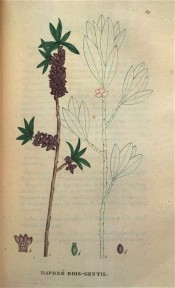Daphne mezereum L.
Fully hardy, upright, deciduous shrub with inversely lance-shaped leaves and lateral clusters of 2-4 fragrant, pink to purplish pink flowers covering the previous year’s shoots, in late winter and spring, before the leaves, followed by spherical, red, poisonous fruit. To 1.2m. [RHSE, Hortus, Hilliers’].
Horticultural & Botanical History
Ancient garden plant, long employed for its medicinal properties. ‘In woods. Rare and local, but widely distributed over England, though probably in many instances, possibly in all, introduced by the agency of birds. The counties where it is most probably native are Dorset, Sussex, Hants, Herts, Berks, and Gloucester. […] The whole plant is a powerful irritant, both bark, leaves, and fruit acting poisonously if taken in large quantities, and readily causing inflammation when applied to the skin or mucous membranes. A few of the berries have been known to cause death when swallowed, and the decoction of the bark, when administered medicinally, has produced unpleasant symptoms. Dr. Taylor, in his work on Poisons, details several cases of poisoning from swallowing the berries, which, however, were treated in time to prevent fatal results. The bark of the root is employed in this country, in the form of a decoction, as a sudorific, alterative, and deobstruent in rheumatism, scrofula, and some cutaneous diseases, being frequently given with sarsaparilla. We find it recognised in the British Pharmacopoeia in a decoction. The bark and wood are similarly used on the Continent. An ointment prepared from the bark has been found beneficial to ulcers. The decoction with carbonate of ammonia is said to have revived patients from collapse resulting from typhus and scarlet fever. It has sometimes removed paralysis of the mouth and the throat. In France the bark is constantly used as an irritant application to the skin as a substitute for blistering. A piece of the fresh bark is dipped in vinegar, applied with the inner surface to the part, and covered over with an ivy or plantain leaf, and renewed twice a day. It soon produces a serous discharge, and, though it affects the skin, is seldom known to raise a blister, and is very sligliily painful, while producing most of the good effects that follow the application of the cantharides plaistor. The berries are used in Germany and Siberia as a cathartic, but are unsafe and dangerous in unpractised hands. According to Linnaeus, they are used in Sweden to poison wolves and foxes. The Russian and Tartar women employ them as a cosmetic, to give their skin a rosy appearance — a dangerous practice if often repeated.’ [English Botany vol.8, p.85/1863-1886].
Flore des Serres figures the variety foliis atro-purpureis. [FS f.592/1850]. Figurd in Saint-Hilaire Tr. pl.70/1825, the illustration used here.
History at Camden Park
Probably short lived in the gardens as it is only listed in the 1845 and 1850 catalogues.
Notes
Daphne mezereum Gueldenst. ex Ledeb. (1841) = Daphne glomerata Lam.
Published Mar 06, 2010 - 04:39 PM | Last updated Aug 01, 2010 - 02:48 PM
| Family | Thymelaeaceae |
|---|---|
| Category | |
| Region of origin | Europe including England, Turkey, Siberia |
| Synonyms | |
| Common Name | Mezereon |
| Name in the Camden Park Record |
Daphne mezereum |
| Confidence level | high |


